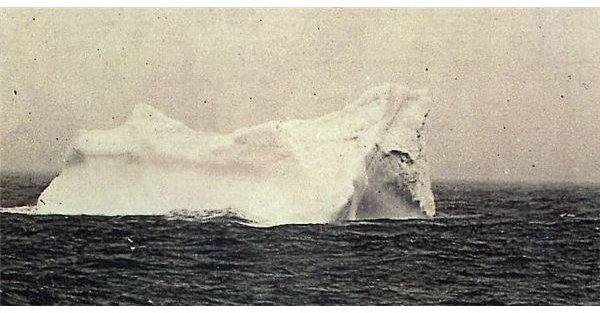History of the Titanic - 100th Year Anniversary
The Iceberg Breaks Free
Greenland is the largest island in the world, lying mostly within the boundaries of the Arctic Circle and dominated by the Greenland Ice Sheet. Here is where the Titanic’s iceberg developed and eventually found its way into the North Atlantic.
In the cold regions of Greenland, there is always movement afoot, especially along the northwest edges of the ice sheet. It is February, 1912, and an iceberg is being born. We are about at 80°N, and the birth is accompanied by much earsplitting and sporadic reverberation. Other than us, this is witnessed only by the polar bears stalking a few seals.
The Petermann Glazier is beginning to calve. A large piece of the ice fractures, and upon shearing from the glazier, is launched into the Arctic Ocean. As it slips away from its home of many thousands of years, it throws a spray into the cold air of the Antarctic Circle, setting up an ocean swell that allows the iceberg to break free at last from its mother’s grasp.
It now embarks on a voyage of destiny with fate, floating southwards through the Arctic Ocean Straights between Canada and Greenland into the north end of Baffin Bay. It picks up the faster moving prevailing ocean currents that propel it ever southwards, crossing over the Antarctic Circle boundary at 65°N into the Labrador Sea before entering the North Atlantic Ocean at 60°N.
Here it begins to slowly traverse this ocean, heading southeastward toward the Titanic almost imperceptibly. Being mostly underwater, it is masked by the ever-present “Newfoundland Fog” that forms where the cold Labrador current meets the warm current from the Gulf Stream.
One possible passage of the iceberg is shown below. (Please click on the image to enlarge.)
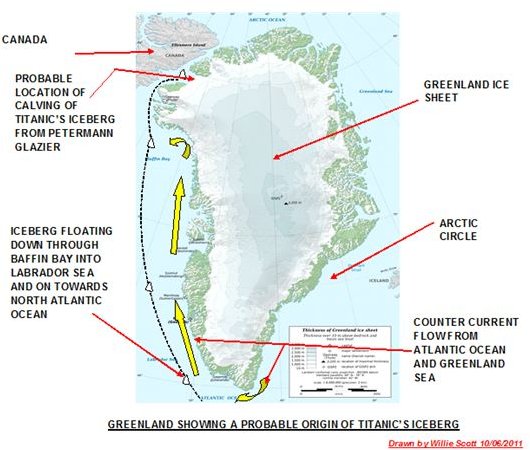
Map of Greenland from Wiki Commons by Ric Gaba; annotations by Willie Scott
History of the Titanic

As the iceberg was heading southeast into the Atlantic, the Titanic had meanwhile finished her sea trials successfully in Belfast Lough and had sailed to Southampton to embark passengers.
There was a wide variety in the background of the passengers. The very wealthy enjoyed the magnificent 1st Class luxuries of the dining halls and bars. These passengers had their own cabins and state rooms on the upper decks, with most being on the outer hull. Some even had doors opening to private verandas. The 2nd Class passengers were from different professional walks of life- engineers, lawyers, doctors and such like. These were four to a cabin, and the cabins were below the waterline. Finally, the 3rd Class passengers, mostly embarked at Cobh in County Cork, consisted of ordinary Irish folk, immigrants hoping for a better life in the New World. They traveled in the stowage/steerage section aft, well away from the other passengers. There were no cabins at all for these passengers; the limited space was divided up and bed-sheets or blankets were hung to provide a little privacy. The entrance/exits doors to the sections were locked to segregate these passengers from the more affluent ones.
There are numerous stories about the passengers and crew; one such story is told about Tommy Miller, an engineer on the Titanic. Miller was from outside Belfast and had served many years in the engine works of Harland and Wolff of Belfast. There he had worked on the engines of the Titanic and had applied for a job as an engineer with White Star, the Titanic’s owners. Clutching a reference from none other than Thomas Andrews, the Titanic’s designer, he passed the interview and was told he would be sailing on Titanic’s maiden voyage.
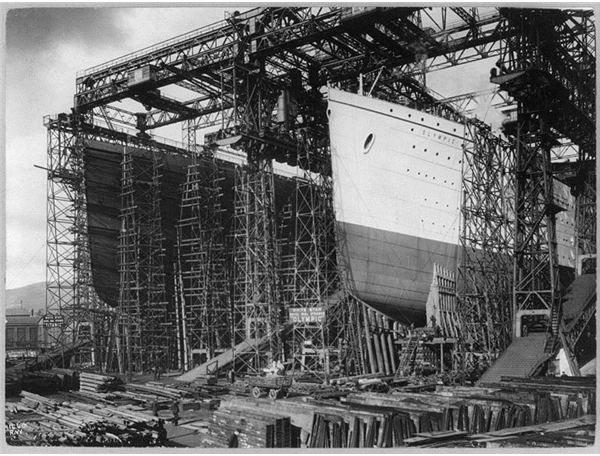
Before boarding the Titanic, Tommy said goodbye to his two sons and gave them two pennies that he had saved from his last wage packet from Harland and Wolff. He told them that they were to keep then until he saw them again.
After a short stop-over in Southampton, the Titanic sailed from there to Cherbourg in France to pick up more passengers, among whom were wealthy American passengers who had been on a European tour.
She sailed from Cherbourg to Cobh in Co. Cork, Ireland to embark up 3rd Class passengers before setting out proper on her fateful maiden voyage to New York on 11th April 1912.
Titanic’s Details
Titanic was primarily designed and built to capture the lucrative North Atlantic passenger trade between Europe and America. She would also carry Royal Mail (thus her title of RMS – Royal Mail Ship) and general cargo as well as frozen meat.
- May 31st 2011 marked the centenary anniversary of Titanic’s launch.
- Titanic set sail on her maiden voyage from Cobh in Co. Cork on 11th April 1912 at 2.30pm.
- The number of passengers onboard was 1,316.
- Engines: 3 Harland and Wolff triple expansion steam engines driving 3 props.
- She was built for the White Star Line by Harland and Wolff Belfast.
- Tonnage: Over 46,999 tons
- Length: 880 feet
- Speed at collision: reputed to be 21 knots
Right into the Iceberg
Thus it is that we find the Titanic a few days out from Cobh, steaming through a relatively calm Atlantic Ocean at her designed speed of 21 knots. This enabled the 1st and 2nd class passengers time to relax or play deck games during the day; nighttime saw them dressed in all their finery for dinner and then dancing well into the small hours. The 3rd class made their own entertainment, with the Irish and Scots leading the way with their Celtic music and dancing below deck.
So the passengers and crew were falling into the ship’s routine when the morning of Saturday April 13th found them steaming into fog as the temperatures plummeted. Only the hardy were taking their morning constitutional stroll around the deck before breakfast.
On the bridge Captain Smith was reviewing messages from other ships warning of low temperatures and thick fog ahead, accompanied by quantities of field ice. These messages were followed later by more reports of fog and the sighting of three large icebergs.
The captain chose to ignore these reports and kept the engines at full revs. He was determined to set a new record for the fastest crossing of the Atlantic. That night entertainment went on as usual, with no one aware of what the next 24 hours would bring.
As Sunday April 14th dawned, the Titanic was still shrouded in heavy fog, her foc’sle barely visible, but she maintained her speed and heading.
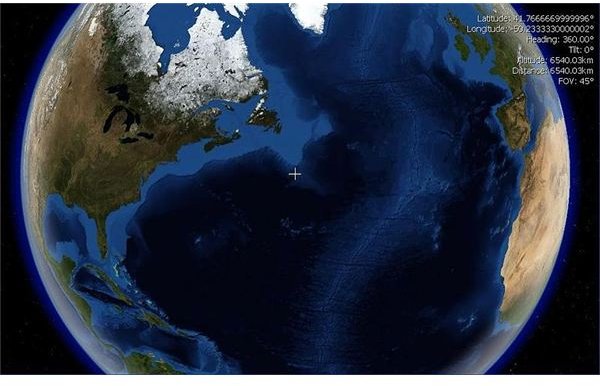
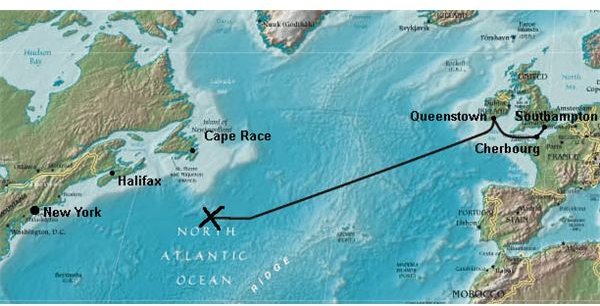
The lookouts were posted on the fo’c’sle head and high above the deck in the crow’s nest, and it was from here that at 11:40 PM the shout went out, “Iceberg ahead.” The wheel was put hard a’port and for a few seconds it seemed that the ship had missed the iceberg, but she had been dealt a fatal glancing blow on her starboard accompanied by a ripping sound that vibrated through the ship and was heard by many of the passengers and crew.

Thomas Andrews, the Titanic’s designer was on board, and accompanied by the several deck officers, among them the Bosun and Chief Officer, carried out a thorough inspection below.
He returned to the bridge to inform Captain Smith that the Titanic had sustained severe damage to the starboard for’d hull. This was mainly under the waterline, and was sinking as he spoke, having only a few short hours to live.
The captain ordered “Abandon Ship” and the officers started to uncover the lifeboats as the passengers, women and children first, made their way to the lifeboats in their lifejackets carrying only their valued possessions.
Down below, the 3rd class passenger’s exits were still locked and there was a state of alarm as water started to ingress into their living areas. They were eventually freed and made their way topsides. Here they were greeted by the sight of emergency flares lighting up the sky and the ship’s horn blasting out the forlorn abandon ship signal. On the boat deck women and children were saying a tearful and reluctant farewell to their menfolk as they embarked the in lifeboats, and rightly so as many of them would never see their loved ones again.
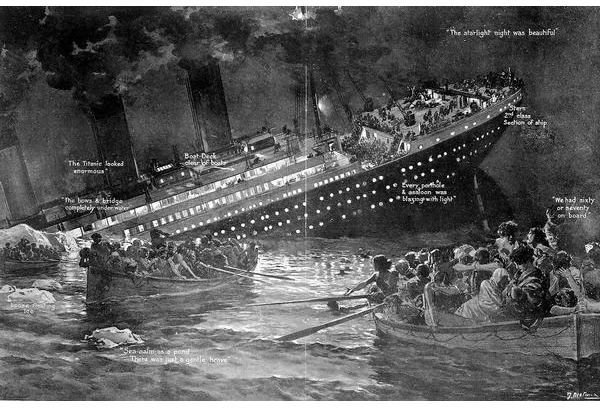
“Oh help us when we cry to thee; for those in peril on the sea.”
Two Pennies
So what happened to Tommy Miller, the engineer from Belfast who gave his two sons a penny each to keep until they saw him again?
Tommy went down with the Titanic, never to see his boys again, but the pennies have been passed down the Miller family through the generations and are now in the possession of Susie Miller, Tommy’s great-granddaughter and the author of a book about him.
References
1. newhorizonexpeditions: Greenland background
2. thetwopennies: A true story from the Titanic.
3. nasa.gov: Glazier calving iceberg image.
4. titanic-titanic: Facts about the Titanic.
5. [titanic](/tools/, http:/www.the-titanic.com/Titanic-Today/Titanic-Places.aspx?utm_source=Hero%2BItem%2BTitanic%2BPlaces&utm_medium=Hero%2BItem%2BTitanic%2BPlaces&utm_campaign=Titanic%2BPlaces%2Bhero%2Bitem): Titanic today
Author’s Note
Many years ago when I was a twenty-year-old engineer on a cargo ship plying the north Atlantic between UK and Canada, I had experience with these very conditions off the coast of Newfoundland. Our radar had broken down, with its chain-drive splitting and lost overboard.
I was on watch when the captain phoned down to apprise me of the situation: heavy sea-fog and lots of growlers (small bergs) and larger ones about. We had lost the radar! He requested minimum engine revs and told me the Chief was coming down.
The Chief Engineer arrived in the engine-room, and after stopping the engine, sent me down the tunnel to remove the chain from the stern-gland greasing mechanism.
I achieved this, gave the chain to the Chief, and restarted the engine at minimum revs.
Well, the radio officer had the job of replacing the chain drive, which was the same pitch. He did this successfully, and we had our electric eyes back again.
